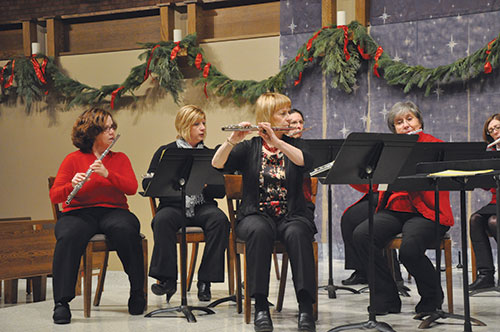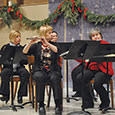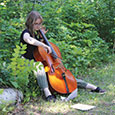One of the best things about playing in a flute choir or community band is the camaraderie that develops among the musicians from making music with a group of people of all ages and levels of proficiency. However, playing in a flute choir comes with some responsibilities and challenges too.
Commit
If you join a flute choir, commit to being there. Rehearsals are important for learning to play well together and to improve your skills. If you must miss more than two rehearsals, sit the concert out. Be sure your flute is in good working order and that you have checked the placement of your cork recently. Work with a tuner at home so you know the pitch tendencies of your instrument.
Bring a pencil to all rehearsals. When the conductor speaks, write down suggestions in the part so you remember what to do from one week to the next. Write down at the beginning of each piece who, besides the conductor, you should look at to start. Mark instructions about fermatas. Is the cutoff the new preparation or will there be another? Circle rests in which no one plays. At the concert, you do not want to be looking around to see who starts after the pause.
Be Agreeable
Accept any part you are assigned to play. Everyone can’t play first on each piece. You may find that playing harmony is actually quite satisfying. Or, that part 5 has a big solo in the low octave and needs a player with this quality. Playing the bass line will develop your ear and help you learn more about theory. As a director, I prefer when flutists can play all flutes rather than specializing on bass or alto. The flute choir will be better musically if all players develop first flute skills.
How to Sit
Flutists who have had more recent training generally sit with the chair positioned 45 degrees to the right with the torso to the right and the head turned to the left with the end of the flute forward. Give this position a try if you learned differently, and you may find that your neck and back no longer ache after playing. This is especially true for those playing alto and bass flutes.

Fox Valley Flute Choir
Warmup
Most flute choirs spend between 15 and 30 minutes on a group warmup. Note these exercises in your flute journal and practice them during the week. With time, you will be able to play scales, thirds, arpeggios etc. in all keys easily and quickly. If your conductor does not spend time with a warmup, during the week practice from either the 17 Big Daily Exercises by Taffanel & Gaubert or The Flute Scale Book by George & Louke. They cover five-note patterns, scales and modes, thirds, arpeggios, seventh chords and so forth. If you suffer from rhythm issues, look at one of the rhythmic band book studies by Grover Yaus.
The Attack
Older musicians tend to play late on the beat, while younger ones are early. Playing on the beat is the goal for flute choirs. The key to playing on the beat is for everyone to subdivide. However, being able to subdivide and play at the same time can be tricky, especially if you are coming back to the flute after a long break. Buy a metronome with a voice function and set it to speak the subdivisions of what you are working on. Hearing someone else counting aloud will help you learn to count in your head.
The style of tonguing has changed in the U.S. Most older players were taught to tongue behind the top teeth. However, tonguing behind the teeth allows some air to escape, producing a tone, before the attack. This is called a hoot attack. To avoid this, European flutists let the tongue move forward between the teeth and tongue in the aperture or on the top lip. This allows the tongue to release the air. Start slowly to evolve into this type of tonguing. It took me about six months to accomplish this.
Vibrato
The consensus now is that vibrato is produced in the vocal folds, not by the diaphragm. To learn this, take a one-octave scale and place three HAHs on each note followed by a rest very softly. When doing the HAHs, there should be no movement in the jaw, chest, or abdomen. If there is, then play even softer. Once you can do the counted HAHs very softly and cleanly, simply repeat, slurring the staccato HAHs. Next, select a tune or hymn and place four measured or counted vibratos per quarter note (six for a dotted quarter). Work with the metronome set at 60 to the quarter.
When playing melodies in the flute choir repertoire, it is easy to stop the vibrato when moving from one note to the next. To avoid this, practice counted vibrato on each note of an ascending scale. Start with the metronome set on 60 and place 2, 3, 4, 5, or 6 on each note. The goal (with a very few exceptions) is to have a continuous vibrato as you move through the notes.
Remember, just as it is in orchestra, the lower instruments vibrato more slowly than the higher instruments. The piccolo will vibrate the fastest and the contra the slowest. So, practice vibrato with the metronome set between 60 and 80.
Starting New Repertoire
When sightreading, experienced players can look at a phrase and know what they want to do with it before they play. However, less experienced players want to hear it first and then add the phrasing in on repeated playthroughs. Sightread an etude at a moderate level for you each time you practice to improve these skills. Remember once you start, don’t stop and just keep on going no matter what happens. Look at etudes by Gariboldi for this purpose (www.imslp.org for free downloads). Select ones that are at various tempos.
Tempo
Elizabeth Green, a former conducting teacher at the University of Michigan, wrote that the best orchestras can play faster and slower than anyone else, but amateurs like to play moderato. This is true for flute choirs as well. At the beginning of each flute choir piece, there usually is a metronome marking. Practice the music so you can play several notches above the tempo indication. Usually when flutists drag, it is because their technical skills are lacking. Work with the scale books mentioned above and with etudes by Berbiguier, Andersen, and Altes. The better solo flutist you are, the better chamber musician you will be and visa versa.
Rhythm
Joan Marie Baumann (Flute Talk, May 1989) wrote an article on the teaching of Marcel Moyse that included this comment. “There is the rhythm, and there is the life of the rhythm. The rhythm without life is nothing; it is dead. One must always find the rhythmic life of each phrase.” What he is saying here is that each rhythm means something and should be inflected with that emotion. Rhythmic inflection has to do with the strength of the beats and a clear understanding of whether a note is on a down beat or up beat. When playing in flute choir, imitate your section leader so you play in the same style and with energy.
Block Scoring
Some flute choirs have everyone in the group playing at the same time with similar rhythms. This is called block scoring. These are the easiest pieces to play. However, the more interesting repertoire has independent parts talking with each other. Since you may not be playing with everyone, counting is a necessity. Count, count, count. If you try to do this by listening only, you will always be late on the beat.
Balance
Players in any group struggle to figure out whether at any given point their part is the solo or the accompaniment. Since most members of the flute choir will not have access to the score, this is something the conductor must teach if the end result is to be musical. Both bringing out and suppressing a line require dynamic control. Most groups can play louder, but few can play softer. Each player should circle with a red pencil all the pianos in the piece.
Many players do not understand the difference between a solo piano and an accompaniment piano – or a solo forte and an accompaniment forte. In both cases the solo dynamic is louder. The number of flutists assigned to each part will determine how loud a section can be played. I heard a conductor ask, “How many flutes are on that forte passage?” “Three.” Okay, so each of you play a third of a forte because if you each play forte, then the passage will sound like fff.
Besides working on your beautiful, rich, full vibrant tone, work to achieve the same results only at the piano dynamic.
Chamber Music Style
String players usually learn from an early age how to play with others in a quartet. They are taught to keep their stands low and to have eye contact with other players. Since most flutists do not have this experience, it is something that takes practice. Obviously, players look at the conductor and section leader to begin the piece, but most need to check in more often than they realize. At your next rehearsal, practice looking up and around every measure or two. Note who is playing the same part as you, and who is playing something else.
Players who breathe together play together. Section leaders should indicate each entrance and cutoff with the end of the flute. If players do not feel comfortable giving a cue, they should work on this skill, or someone else should lead the section.
Set Up and Break Down
Be sure to arrive early to help set up the chairs and stands and stay after to put everything away. Volunteer to help out the group in other ways such as publicity, library duties, and recruitment, especially if you have any special skills or contacts that would apply.
Partner Practice
Find a friend to practice your flute choir music with once a week. Even if one of you is on part 3, and the other plays part 6, there will be things that you learn that will help you to be a better ensemble player.
Weekly flute choir rehearsal are a wonderful chance to be among friends who have a shared interest in the flute and flute playing. Improving your skills will make this an even better experience as you work together to create beautiful music.






